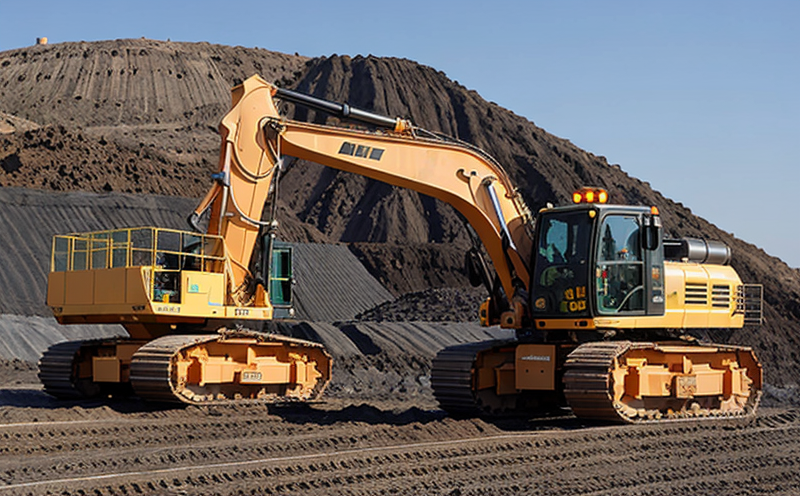EN 16228 Drilling and Foundation Equipment Safety Testing
The European Standard EN 16228 is a critical document in the safety assessment of drilling and foundation equipment used in mining operations. This standard provides detailed requirements for the design, construction, testing, and approval of this type of equipment to ensure it meets stringent safety criteria. The primary objective of this test is to prevent accidents that could endanger workers or cause significant property damage.
The standards outlined in EN 16228 are derived from a comprehensive analysis of potential hazards associated with drilling and foundation equipment. These hazards include but are not limited to mechanical failures, electrical malfunctions, and improper operation leading to personal injury or structural collapses. Compliance with this standard is mandatory for manufacturers looking to sell their products within the European Union.
The testing procedure involves rigorous examination at various stages of development including prototype design reviews, finite element analysis (FEA), and preliminary hazard assessments. Once prototypes are ready, they undergo specific tests designed to evaluate strength under load conditions, electrical insulation integrity, vibration resistance, and other critical performance metrics relevant to their intended use.
During the testing process, specialized instruments such as strain gauges, accelerometers, and torque sensors may be employed to monitor real-time data during simulated operational scenarios. This allows engineers to identify any weaknesses or areas requiring improvement before full-scale production begins. After successful completion of all prescribed tests according to EN 16228 guidelines, manufacturers receive certification which they can then use as evidence of product compliance.
It is important for companies involved in the mining industry to understand how these tests impact their overall quality management systems and supply chain strategies. By ensuring adherence to international standards like EN 16228 early on in the product lifecycle, organizations can reduce risks associated with non-compliance later down the line.
In summary, compliance with EN 16228 is essential for any manufacturer of drilling or foundation equipment used in mining operations. It ensures not only regulatory conformity but also enhances safety standards which are crucial given the nature of these high-risk environments.
- Ensures mechanical integrity and electrical stability
- Identifies potential hazards early through rigorous testing
- Provides certification for market entry into EU countries
- Promotes safer working conditions by minimizing accidents and injuries
- Enhances reputation among clients who prioritize safety compliance
Why Choose This Test
- Avoids Liability Risks: By conducting EN 16228 tests, manufacturers can significantly reduce their liability exposure by demonstrating due diligence in ensuring product safety.
- Safeguards Workers: Ensures that the equipment used meets high standards of safety which directly translates into reduced risk for workers operating this machinery.
- Compliance Certification: Receive certification from recognized bodies, making it easier to enter new markets and maintain existing ones.
- Increased Market Share: Compliance with international standards like EN 16228 can give companies a competitive edge over non-compliant competitors.
- Better Quality Control: The detailed testing procedures required by this standard help identify issues early in the development cycle, leading to improved product quality.
- Promotes Innovation: Rigorous testing encourages manufacturers to innovate and improve their products beyond basic requirements.
Selecting EN 16228 safety testing ensures that mining equipment meets rigorous international standards, thereby enhancing operational safety and reducing potential risks. This service is particularly valuable for quality managers, compliance officers, R&D engineers, and procurement professionals involved in ensuring the safety and reliability of drilling and foundation equipment.
International Acceptance and Recognition
EN 16228 enjoys widespread recognition across Europe and beyond due to its comprehensive approach towards assessing the safety aspects associated with drilling and foundation equipment. Its acceptance by various regulatory bodies ensures that manufacturers can rely on consistent standards regardless of geographical location.
The European Committee for Standardization (CEN) has approved EN 16228, making it a widely accepted standard within EU member states. However, the principles outlined in this document are also applicable globally, particularly in regions where mining activities are prevalent and safety is paramount.
Compliance with this standard provides manufacturers with an advantage in terms of gaining trust from customers who value safety above all else. It demonstrates a commitment to excellence that goes beyond mere compliance with local regulations, thereby enhancing the company’s reputation within the industry.
In conclusion, EN 16228 is not just another set of rules; it represents best practices for ensuring safety in mining equipment design and manufacture. Its global recognition ensures consistency in quality assurance processes worldwide.
Competitive Advantage and Market Impact
The implementation of EN 16228 has far-reaching implications beyond mere compliance; it plays a crucial role in shaping the competitive landscape within the mining equipment sector. Adhering to these stringent safety standards can significantly enhance a company’s standing among peers, providing substantial benefits both domestically and internationally.
Firstly, by ensuring that all products meet the highest levels of safety as prescribed by EN 16228, companies establish themselves as leaders in their field. This leadership position translates into increased market share, as customers increasingly seek out brands known for prioritizing worker safety over cost-cutting measures.
Secondly, compliance with this standard can open doors to new markets where strict safety regulations are in place but may have previously been inaccessible due to lack of appropriate standards or inconsistent enforcement. For example, countries like Australia and Canada, which have robust mining industries, often require imported equipment to meet local safety standards.
Thirdly, maintaining compliance with EN 16228 fosters continuous improvement within organizations by encouraging regular reviews and updates based on the latest technological advancements and best practices. This dynamic approach keeps companies ahead of competitors who might lag behind in terms of innovation and adaptation.
In summary, while initially seen as a regulatory burden, embracing EN 16228 can be transformative for mining equipment manufacturers seeking to build long-term success through sustained excellence in safety standards.





